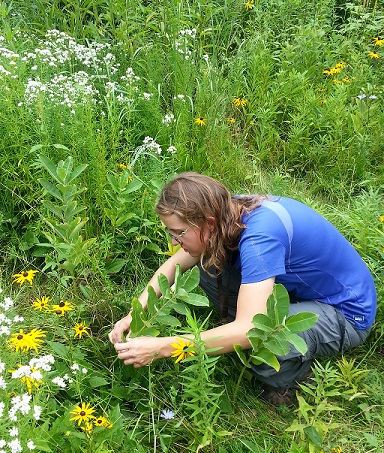"We delight in the beauty of the butterfly, but rarely admit the changes it has gone through to achieve that beauty." – Maya Angelou
Brief Natural History of the Monarch (Danaus plexippus)
Monarchs are a part of the milkweed butterfly group (Danaiinae). Milkweeds (Asclepias spp.) are essential plants in the life cycle of the monarch because eating the plant makes the larva and adults toxic (or at the very least distasteful) to certain predators. Adult monarchs leave Mexico starting in March and arrive in the southern states when they find milkweed. The offspring of the southern state individuals travel further north to summering grounds in more northern latitudes. From April to August, adults produce up to four generations. Once a female adult monarch lays an egg (usually one single egg on the underside of a milkweed leaf), it takes about 4-5 days for the larva to hatch. From there, the larva develops through a series on instars (1-5) that take about 2 weeks. Once the 5th instar is reached, the larva forms a chrysalis for the last step in its development. About 14-16 days later, the adult emerges from the chrysalis. Most adult monarchs live for about a month during the summer. But, the final generation of that season, which consists of the individuals that migrate south, actually live up to 8 months. The journey south to Mexico is by way of southern states and Texas. The main overwintering locations are in the forests of central Mexico.
Monarch Larva Monitoring
All summer long, the Research & Community Science team, along with dedicated volunteers, have been looking on the underside of thousands of milkweed leaves for eggs and monarch instars (caterpillars) as a part of a nationwide community science project. The Monarch Larva Monitoring Project was developed by the University of Minnesota to collect long-term data on monarch populations and their habitat (milkweeds). The information collected helps scientists determine population trends and distributions. The Center has been collecting data on larvae and eggs consistently for the last four years at all three branches. Our Riverside Park dataset covers 9 years: 2003, 2005-2008, and 2011-2014. We average about 9 surveys per year, searching about 100 milkweed plants each survey. You can view the Riverside Park data from the last decade here.
Monarch Tagging

In the past, the Research & Community Science Team, along with our Environmental Educators, have participated in a monarch tagging project. By recording locations of capture and recovery, we can track an individual monarch's pathway along the migration route, all thanks to a small sticker affixed to the back of the monarch wing. It has a six digit code visible through butterfly binoculars or when captured. Monarchs start their migration in mid-August in northern latitudes; tagging starts in late August all over the continent, with a stronger effort in September and October. Peak monarch abundance in Milwaukee is September 3rd-15th. The main questions concern the movement of monarchs across the continent and how temperature and weather affect migration. Our participation in this program has waned in the last few years based on time, but we hope to reinvigorate this important community science project.
Did You Know?
- Monarchs travel up to 3,000 miles during their migration from the northern latitudes of North America to Mexico.
- Recent evidence for decline of the monarchs stems from loss of habitat (due to agricultural pesticide use) and climate change (extreme weather events such as droughts). As milkweeds decline, monarchs decline.
- Monarchs are poisonous to certain predators due to the cardenolide aglycones of the milkweed sap they ingest.
- The monarchs that return to Mexico in the fall are not the same individuals that migrated north in the spring and summer. That means the returning monarchs have never been to Mexico before, but they find their way back nonetheless!
- Only about 10% of the eggs laid by a female monarch survive to adulthood; other insect predators feed on the larva such as stinkbugs, ambush bugs, tachinid flies and ants.
Get Involved!
Please check our Weekly R&R email for more information on monarch larva surveys and monarch tagging! The September 4th tagging session has been canceled because we are still waiting on new 2014 tags. We plan to have a tagging session the week of September 8th, so check the R&R for the most up-to-date schedule! Contact Anne at This email address is being protected from spambots. You need JavaScript enabled to view it.or Jenn at This email address is being protected from spambots. You need JavaScript enabled to view it. for more information.




